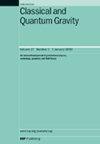superB/NRPy: 3G引力波科学的可扩展、基于任务的数值相对论
IF 3.7
3区 物理与天体物理
Q2 ASTRONOMY & ASTROPHYSICS
引用次数: 0
摘要
现代引力波科学要求越来越精确和计算密集的数值相对论(NR)模拟。基于python的开源NRPy框架为NR生成优化的C/ c++代码,包括完整的NR代码BlackHoles@Home (BH@H),它利用曲线坐标非常适合许多天体物理场景。历史上,BH@H仅限于单节点OpenMP CPU并行性。为了解决这个问题,我们引入了superB,这是NRPy的一个开源扩展,可以从现有的BH@H模块自动生成可扩展的、基于任务的、分布式内存的Charm++代码。生成的代码划分NRPy/BH@H使用的结构化网格,管理它们之间的通信。其正确性通过在单个节点上与标准OpenMP版本的位相同的结果和在圆柱状坐标下的正面二进制黑洞模拟来验证,准确地再现了准正态模式(高达)。superB/ nrpy生成的代码展示了出色的强扩展性,与原始的单节点OpenMP代码相比,在64个节点(7168个内核)上实现了约45倍的加速,用于大型3D真空测试。这种可扩展的基础设施有利于苛刻的模拟,并为未来的多补丁网格支持奠定了基础,目标是长期激励,极端参数研究和快速跟进。这个基础设施很容易与其他NRPy/BH@H-based项目集成,支持广义相对论流体力学代码GRoovy的性能扩展,并通过NRPy- cuda项目促进未来与GPU加速的耦合。本文章由计算机程序翻译,如有差异,请以英文原文为准。
superB/NRPy: scalable, task-based numerical relativity for 3G gravitational wave science
Modern gravitational-wave science demands increasingly accurate and computationally intensive numerical relativity (NR) simulations. The Python-based, open-source NRPy framework generates optimized C/C++ code for NR, including the complete NR code BlackHoles@Home (BH@H), which leverages curvilinear coordinates well-suited to many astrophysical scenarios. Historically, BH@H was limited to single-node OpenMP CPU parallelism. To address this, we introduce superB, an open-source extension to NRPy that enables automatic generation of scalable, task-based, distributed-memory Charm++ code from existing BH@H modules. The generated code partitions the structured grids used by NRPy/BH@H, managing communication between them. Its correctness is validated through bit-identical results with the standard OpenMP version on a single node and via a head-on binary black hole simulation in cylindrical-like coordinates, accurately reproducing quasi-normal modes (up to ). The superB/NRPy-generated code demonstrates excellent strong scaling, achieving an ≈45× speedup on 64 nodes (7168 cores) compared to the original single-node OpenMP code for a large 3D vacuum test. This scalable infrastructure benefits demanding simulations and lays the groundwork for future multi-patch grid support, targeting long inspirals, extreme parameter studies, and rapid follow-ups. This infrastructure readily integrates with other NRPy/BH@H-based projects, enabling performant scaling for the general relativistic hydrodynamics code GRoovy, and facilitating future coupling with GPU acceleration via the NRPy-CUDA project.
求助全文
通过发布文献求助,成功后即可免费获取论文全文。
去求助
来源期刊

Classical and Quantum Gravity
物理-天文与天体物理
CiteScore
7.00
自引率
8.60%
发文量
301
审稿时长
2-4 weeks
期刊介绍:
Classical and Quantum Gravity is an established journal for physicists, mathematicians and cosmologists in the fields of gravitation and the theory of spacetime. The journal is now the acknowledged world leader in classical relativity and all areas of quantum gravity.
 求助内容:
求助内容: 应助结果提醒方式:
应助结果提醒方式:


